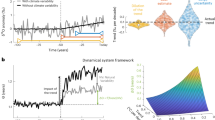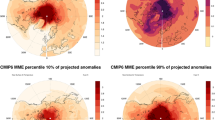Abstract
The polar regions have long been expected to warm strongly as a result of anthropogenic climate change, because of the positive feedbacks associated with melting ice and snow1,2. Several studies have noted a rise in Arctic temperatures over recent decades2,3,4, but have not formally attributed the changes to human influence, owing to sparse observations and large natural variability5,6. Both warming and cooling trends have been observed in Antarctica7, which the Intergovernmental Panel on Climate Change Fourth Assessment Report concludes is the only continent where anthropogenic temperature changes have not been detected so far, possibly as a result of insufficient observational coverage8. Here we use an up-to-date gridded data set of land surface temperatures9,10 and simulations from four coupled climate models to assess the causes of the observed polar temperature changes. We find that the observed changes in Arctic and Antarctic temperatures are not consistent with internal climate variability or natural climate drivers alone, and are directly attributable to human influence. Our results demonstrate that human activities have already caused significant warming in both polar regions, with likely impacts on polar biology, indigenous communities2, ice-sheet mass balance and global sea level11.
This is a preview of subscription content, access via your institution
Access options
Subscribe to this journal
Receive 12 print issues and online access
$259.00 per year
only $21.58 per issue
Buy this article
- Purchase on Springer Link
- Instant access to full article PDF
Prices may be subject to local taxes which are calculated during checkout




Similar content being viewed by others
References
Meehl, G. A. et al. in The Fourth Assessment Report of the Intergovernmental Panel on Climate Change (eds Solomon, S. et al.) (Cambridge Univ. Press, 2007).
Symon, C., Arris, L. & Heal, B. (eds) Arctic Climate Impact Assessment (Cambridge Univ. Press, 2004).
Johannessen, O. M. et al. Arctic climate change: Observed and modelled temperature and sea-ice variability. Tellus A 56, 328–341 (2004).
Wang, M. Y. et al. Intrinsic versus forced variation in coupled climate model simulations over the Arctic during the twentieth century. J. Clim. 20, 1093–1107 (2007).
Polyakov, I. V. et al. Variability and trends of air temperature and pressure in the maritime Arctic, 1875–2000. J. Clim. 16, 2067–2077 (2003).
Overland, J. et al. The Arctic and Antarctic: Two faces of climate change. Eos Trans. AGU 89, 177–178 (2008).
Turner, J. et al. Antarctic climate change during the last 50 years. Int. J. Climatol. 25, 279–294 (2005).
Hegerl, G. C. et al. in The Fourth Assessment Report of the Intergovernmental Panel on Climate Change (eds Solomon, S. et al.) (Cambridge Univ. Press, 2007).
Brohan, P. et al. Uncertainty estimates in regional and global observed temperature changes: A new data set from 1850. J. Geophys. Res. 111, D12106 (2006).
Jones, P. D. et al. Surface air temperature and its changes over the past 150 years. Rev. Geophys. 37, 173–199 (1999).
Lemke, P. et al. in The Fourth Assessment Report of the Intergovernmental Panel on Climate Change (eds Solomon, S. et al.) (Cambridge Univ. Press, 2007).
Jones, P. D. Antarctic temperatures over the present century—a study of the early expedition record. J. Clim. 3, 1193–1203 (1990).
Trenberth, K. E. et al. in The Fourth Assessment Report of the Intergovernmental Panel on Climate Change (eds Solomon, S. et al.) (Cambridge Univ. Press, 2007).
Connolley, W. M. & Bracegirdle, T. J. An Antarctic assessment of IPCC AR4 coupled models. Geophys. Res. Lett. 34, L22505 (2007).
Gleckler, P. J., Taylor, K. E. & Doutriaux, C. Performance metrics for climate models. J. Geophys. Res. 113, D06104 (2008).
Monaghan, A. J., Bromwich, D. H., Chapman, W. & Comiso, J. C. Recent variability and trends of Antarctic near-surface temperature. J. Geophys. Res. 113, D04105 (2008).
Monaghan, A. J., Bromwich, D. H. & Schneider, D. P. Twentieth century Antarctic air temperature and snowfall simulations by IPCC climate models. Geophys. Res. Lett. 35, L07502 (2008).
Stott, P. A. & Tett, S. F. B. Scale-dependent detection of climate change. J. Clim. 11, 3282–3294 (1998).
Marshall, G. J., Orr, A., van Lipzig, N. P. M. & King, J. C. The impact of a changing Southern Hemisphere Annular Mode on Antarctic Peninsula summer temperatures. J. Clim. 19, 5388–5404 (2006).
Chapman, W. L. & Walsh, J. E. A synthesis of Antarctic temperatures. J. Clim. 20, 4096–4117 (2007).
Thompson, D. W. J. & Solomon, S. Interpretation of recent Southern Hemisphere climate change. Science 296, 895–899 (2002).
Marshall, G. J. Trends in the Southern Annular Mode from observations and reanalyses. J. Clim. 16, 4134–4143 (2003).
Stott, P. A. et al. External control of 20th century temperature by natural and anthropogenic forcings. Science 290, 2133–2137 (2000).
Allen, M. R. & Stott, P. A. Estimating signal amplitudes in optimal fingerprinting, part I: theory. Clim. Dyn. 21, 477–491 (2003).
Gillett, N. P. et al. Detecting anthropogenic influence with a multi-model ensemble. Geophys. Res. Lett. 29, 1970 (2002).
Allen, M. R. & Tett, S. F. B. Checking for model consistency in optimal fingerprinting. Clim. Dyn. 15, 419–434 (1999).
Przybylak, R. Temporal and spatial variation of surface air temperature over the period of instrumental observations in the Arctic. Int. J. Climatol. 20, 587–614 (2000).
Przybylak, R. Changes in seasonal and annual high-frequency air temperature variability in the Arctic from 1951 to 1990. Int. J. Climatol. 22, 1017–1032 (2002).
Polyakov, I. V. et al. Observationally based assessment of polar amplification of global warming. Geophys. Res. Lett. 29, 1878 (2002).
Stroeve, J. et al. Arctic sea ice decline: Faster than forecast. Geophys. Res. Lett. 34, L09501 (2007).
Acknowledgements
We thank S. Solomon, G. Marshall and H. Melling for useful advice and discussion; M. Allen for his optimal detection and attribution code; and G. Jones for assistance with the provision of model output. This work was supported in part by the Climate Change Detection and Attribution Project, jointly funded by NOAA’s Office of Global Programs and the US Department of Energy. N.P.G. and A.Y.K. were also supported by NERC grant NE/E006787/1, and N.P.G. acknowledges support from the Leverhulme Trust. P.A.S. was supported by the Joint Defra and MoD Programme, (Defra) GA01101 (MoD) CBC/2B/0417 Annex C5.
Author information
Authors and Affiliations
Contributions
N.P.G. carried out most of the analysis and wrote the paper. D.A.S., P.A.S., T.N. and M.F.W. assisted with the provision of model data. A.Y.K. calculated SAM trends and regression patterns. G.C.H. proposed the study. P.D.J. provided advice on observations.
Corresponding author
Supplementary information
Supplementary Information
Supplementary Information (PDF 1353 kb)
Rights and permissions
About this article
Cite this article
Gillett, N., Stone, D., Stott, P. et al. Attribution of polar warming to human influence. Nature Geosci 1, 750–754 (2008). https://doi.org/10.1038/ngeo338
Received:
Accepted:
Published:
Issue Date:
DOI: https://doi.org/10.1038/ngeo338
This article is cited by
-
The quandary of detecting the signature of climate change in Antarctica
Nature Climate Change (2023)
-
Exploring late Pleistocene bioturbation on Yermak Plateau to assess sea-ice conditions and primary productivity through the Ethological Ichno Quotient
Scientific Reports (2023)
-
Quantifying contributions of ozone changes to global and arctic warming during the second half of the twentieth century
Climate Dynamics (2023)
-
A bibliometric and scientometric: analysis towards global pattern and trends related to aerosol and precipitation studies from 2002 to 2022
Air Quality, Atmosphere & Health (2023)
-
Climate warming amplified the 2020 record-breaking heatwave in the Antarctic Peninsula
Communications Earth & Environment (2022)



